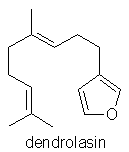
Cropwatch
Issue 2.
Copyright
Tony
Burfield & Chrissie Wildwood Feb 2004.
AUSTRALIAN
SANDALWOOD OIL:
A
TALE OF SPIN & HYPE?
- By Tony Burfield
& Chrissie Wildwood
Pacific
Sandalwood : A History of Australian exploitation.
Historically, the huge
demand for sandalwood as an incense ingredient in China & SE Asia led to
mass exploitation of the resource. Indeed, in her book, They
Came for Sandalwood, Dorothy Shineberg describes the deeds of opportunist
traders in the South Pacific (1820-1865), and tells of warring confrontations
between European and Melanesian cultures in New Caledonia, the New Hebrides and
the Loyalty Islands. To satisfy the English demand for tea, sandalwood became
the currency for supplies of tea imported from China. This gave impetus to
explorer-traders like Dillon and Towns, who discovered exploitable amounts of
sandalwood tree species on many islands, especially Erromango.
By 1860, thousands of islanders had been slaughtered, and the Pacific
sandalwood resources were plundered to near extinction.
Nowadays, Pacific sandalwood (what little of it remains) is an important
source of revenue for some Pacific islanders.
On sandalwood, Septimus
Piesse (1855), the famous 19th Century French chemist perfumer notes
that “…continuous offerings to the Buddhas have almost exterminated the
plant from the Celestial Empire and such is the demand that it is about to be
cultivated in West Australia in the expectation of profitable return, which we
doubt will be realised.”
But to reduce the expense
of importing tea into New South Wales, the trading of Pacific sandalwood by
Australian merchants, especially at the time
Piesse published his book, had been a positive economic factor. The trading
volumes since then have had their ups and downs.
For example, in 1957 the trade in Santalum
spicatum was totally shut down. However, in the past few years, and against
a background of over-exploitation of Santalum
album in India, and with the ravages of spike disease causing additional
problems, Australia’s native Sandalwood resource has once again become an
important trading commodity. As we
shall see, however,
the industry seems to have made a number of errors of judgement….
Australian
Sandalwood: the facts without the sales hype.
Sandalwood species
Six Santalum
species occur in Australia: (Flora of
Australia vol 22 Austr Govt Publ Service Canberra 1984)
S. acuminatum
(R. Br.) A. DC.
S.
album L
S.
lanceolatum R.
Br.
S.
murrayanum
(Mitchell) C. Gardn.
S.
obtusifolium R.
Br.
S.
spicatum (R. Br.)
A. DC.
However, only two species
have been economically important. Santalum lanceolatum (Northern Sandalwood) is the most
widespread of the Santalum spp. in
Australia (Applegate et al.1990), and exports of this species were worth $4.2
million in 1989. The authors preface the article with a quote from Sawyer
(1892):
“The trade in this
fragrant wood has been going on since the dawn of history and will probably not
cease until the connection between the sandal trees and the idolators existing
from time immorial, shall have been broken up, by one or another becoming
extinct as a race as the Archaepteryx or the Dido.”
The authors go on to
report, “the first recorded export of Sandalwood was from the State of Western
Australia in 1846 when 4 tons were sent abroad for oil production.” Interestingly, a colossal 4 tons of aromatic S. lanceolatum logs were used for Gandhi’s
cremation in 1948. Applegate et al. also
describe how Unex industries (Australia) Ltd secured sole rights to purchase
sandalwood (S. lanceolatum) from Crown
Island in Queensland for a period of 20 years, but alleged breaches of contract
caused Queensland Forest Services to revoke this contract in 1989. Wood
harvesting from Crown Land has been more important and harvesting guidelines
have been established to manage the resource for conservation, such that no more
than 50% of existing stands are harvested, and limiting the wood harvesting to
equal or greater than 12cm. d.b.h. to ensure that the theoretical heartwood
recovery constitutes at least 30% of the wood harvested.
Ethno-botanical use of
northern sandalwood species by aboriginals is reported by Sansom (1980), through
Stateham (1990) and Tonts & Selwood (2002).
Here it is revealed that the northern species of sandalwood were, and
still are, highly prized by the aboriginals, as the wood and its scent are
regarded as fundamental elements in sex-magic.
A brief aromatic history
Australia has a history
of marketing raw materials from its aromatic shrubs and trees, spanning the 19th
and 20th centuries. Essential
oil production was focussed on isolating specific perfumery components, until
the introduction of cheap synthetic perfumery materials caused a decline, if not
virtual abandonment, of the industry. Despite experience in aromatic raw
materials production, the development of the perfume manufacturing industry in
Australia was never realised to the extent of the prestigious perfume houses of
Europe.
The emergence of
aromatherapy, coinciding with renewed interest in natural materials specifically
for the flavourings market, provided impetus for a regeneration of the
Australian essential oils industry. Commodities such as Tea Tree oil became much
sought-after ingredients. However, competition between producers became fierce,
and eventually individual companies were forced to forward sell their annum
production at prices below the cost of production, inevitably leading to a
collapse of certain operations. Subsequent competition from Zimbabwe, South
Africa and China has combined to keep selling prices low for Tea Tree oil.
Accounts of the decline, and how growers subsequently clubbed together to
seek tax relief on diesel used in the distillation, can be glimpsed at
http://www.abc.net.au/7.30/stories/s139789.htm
and http://fueltaxinquiry.treasury.gov.au/content/Submissions/Industry/NQEO_100.asp
China continues an aggressive low-pricing sales policy which has limited the potential sales of other essential oils produced in Australia, such as Eucalyptus globulus and Lavandula angustifolia.
WA Sandalwood
Tonts & Selwood
(2002) describe the reinvention of Australia’s sandalwood industry and report
how the once abundant tree Santalum spicatum has been
largely cleared from areas 300-600m (due to conversion of the natural woodland
to sheep and wheat farming). Although
a slow-growing species taking some decades to mature, depending on annual
rainfall and other factors, formerly the tree grew optimally in these areas.
At a distribution of 1-2 plants per hectare, it is still present in the
42 million-acre arid zone. Unfortunately,
susceptibility to fire & ant attack, grazing by wild animals, heartrot - and
especially creeping salination - are survival threats.
Much has been made of the fact that plantations of S. spicatum with integral host species such as Acacia acuminata
(in the Wheatbelt region) or Acacia aneura (in the Golfields region)
may help counter the effects
of Australia’s massive problem of creeping salination, caused by massive
land-clearing of native vegetation (Blacklow 2003). However, a study by Woodall
& Robinson (2003), working in the Pallinup river catchment area of SW
Australia, is revealing. The
authors suggest that, in reality, the small size of these sandalwood plantation
schemes is unlikely to address the salinity crisis through broad-scale recharge
management. Indeed, a source of more biodiverse plantation schemes is required
to bring benefits, although it is difficult to
know where funding for such a complex project is likely to be obtained –
despite pleas for “a cultural change” (Blacklow et al 2003). Meanwhile, land
clearance continues.
CALM (Department of Conservation and Land Management) is the Australian
agency responsible for administering the 1929 Sandalwood Control Act, awarding
contracts to private companies to harvest sandalwood, and overseeing the amount
and minimum size of sandalwood that can be removed from individual stands by
reference to, and consideration of, its inventory data. CALM also encouraged
studies leading to a better understanding of Sandalwood cultivation,
such as the report of Lonergan (1990) which describes and eventually summarises
the conclusions from the WA Sandalwood research program (1895-1981) in eleven
succinct points. Point eleven describes the technique of artificial regeneration
of Sandalwood on a planting scale. Lonergan concludes that potential for
widescale regeneration and establishment of sandalwood in W Australia is
feasible “if the natural limitations on this species are recognised.”
McKinnell (1990) describes typical harvesting: “… licensed “pullers “are allocated an annual quota of so many tons of green or dead wood…. Sandalwood “pullers” are permitted to take only those live trees with a girth greater than 40cm at 15cm above the ground. Dead trees of any size are taken. Currently about half the sandalwood harvest is of dead wood, a consequence of periodic drought and a series of large wildfires several years ago (Keally 1987). At present this is restricted to 2,000 tons per year.”
In 1995, the
marketing monopoly was removed from the Australian Sandalwood Company, allowing
the newcomer, Westcorp Sandalwood Inc., to emerge. New Mountain, a Westcorp
company, won a contract with the Forest Products Corporation to remove up to 200
tons of Sandalwood per year to make incense sticks to repel mosquitoes (Safstrom
2002). Tonts & Selwood (2002)
also describe
Mount Romance’s establishment in Albany 1999, now having a contract with CALM
for 1,000 tons of sandalwood per annum.
Mount Romance was
founded by Steve Birkbeck, who rose to some renown in the Australian business
world when in 1981 he
successfully took charge of a “forgotten peoples” emu company in Wiluna, W.
Australia. This formed part of a larger group of indigenous farming enterprises
focused on crocodile, turtle and emu products
(RIRC
undated). Within a few years he
became the celebrated pioneer of emu farming in Australia, the birds being
exploited for meat and the rendered oil, the latter being used in the cosmetics
trade. Opposition to current practises of emu farming by the Australian Royal
Society for the Prevention of Cruelty to Animals can be viewed at
http://www.rspca.org.au/pdf/B_policystatements.pdf
Birckbeck’s enterprise
based in Albany continues to market health and beauty products based on emu oil,
alongside sandalwood-based products. Yet it is noted by the authors
with some irony that Mount Romance’s aggressive
marketing operation has resulted in the company’s WA sandalwood oil being sold
into “Cruelty Free” products in Australia and the USA.
Earlier on, and
apparently talking-up the market, John Fergeus (1990), owner of an Australian
essential oils company, wrote an influential article in the trade magazine Perfumer
& Flavourist entitled “What will be the Next Big Oil from
Australia?” With the Australian
government seemingly ready to throw any amount of money at essential oils, and
with a posse of obedient botanists and University workers in tow, it would seem
that the Australian oils trade could not fail to succeed. Writers like Webb
(2000), acting as an oil trade publicist, would give glowing descriptions of
Australian essential oils, and Australian magazines such as Aromatherapy Today, edited by essential oil seller John Kerr, would
further worshipfully exalt essential oils and their properties to almost magical
status. In all these accounts, almost no critical overview is to be found.
But what of the
marketable Australian oils, post Tea tree oils’ crash in selling price? Manuka
(Leptospermum scoparium)
and Kanuka (Kunzea ericoides) oils,
once tipped be successors to Tea Tree’s success, failed to sell on the same
scale, and anyway are more strictly associated with New Zealand. Rosalina oil
from Melaleuca ericifolia, a more
acceptable and floral oil compared to the aromatic earthiness of Tea Tree, was
heavily promoted as “Lavender Tea tree”, but in a similar way failed to
catch the customer’s imagination. Backhousia
citriodora, an interesting oil comprised mainly of citral and citronellal,
had skin safety problems associated with its’ high aldehyde/allergens content,
which limits its more widespread use in perfumery & aromatherapy.
The rising price and
unavailability of East Indian Sandalwood, however, gave the Australian essential
oils industry a unique opportunity. Since
Santalum spicatum
logs were already being exported to China (80% of which are powdered for incense
sticks [Denham 1998]), and Chinese demand for wood was said to be increasing 50%
year on year (Henschke 2000),
a lucrative opening would be to produce a highly prized essential oil in
addition to shipping timber.
Marketing WA Sandalwood oil.
The opportunist marketing departments of Mount Romance, Australian Botanicals and other oil suppliers have been quick to point out the problems with the supply of East Indian Sandalwood oil (Anon 2002; Fergeus undated). However, the cosmetic trade press, which has featured articles on the oil in question, usually only prints features forwarded by writers representing producers and suppliers, resulting in content which resembles an advertisement, rather than balanced informative articles with a critical overview. Let us continue, therefore, with some issues around WA Sandalwood that the trade does not want to talk about…
Product Definition problems
In an article about
Western Australian Sandalwood oil published in Aromatherapy
Today, Kerr (2000) was decidedly coy about revealing the solvents employed
in the production process; Webb’s book, Bush
Science (Webb 2000), cited in the same article, describes the principles of
process on pages 16-17, but again declines to identify the solvents. Later
however, Valder et al. (2003) give the exact preparation method for Mount
Romance sandalwood oil, as featuring hexane extraction, followed by
co-distillation with propylene glycol, followed by rectification. Passing over
the question of why a readership of essential oil chemists is apparently
entitled to know what aromatherapists are not, it is clear that this product
then, is an extract, not an essential oil since it doesn’t conform to the ISO
9235-1997 and Pharmacopoeia definitions of essential oils. The solvent extract
(prior to the co-distillation stage), if all hexane was removed, would be
defined as a concrete; for example Butaud et al. (2003) recently describe
sandalwood concretes made by solvent extraction using chloroform. Gearon (2002)
had already defensively remarked on this issue: “By definition, an essential
oil is the volatile oil forming the odorous principle of plants.* Of course,
this is open to selective interpretation, depending on motive”.
Never was a truer word spoken!
Earlier, Gearon (2000),
quoted on a commercial oil-sellers magazine page, attempts to justify the
extraction process for Australian Sandalwood oil with an attempt to rewrite the
definition of “natural” with a confused train of thought,
which can be followed at http://www.essentiallyoils.com/Newsletters/October_2000_Newsletter/october_2000_newsletter.html
In this feature, Gearon
advises the Newsletter that Mount Romance uses a “high grade pure solvent”
(which is apparently “removed entirely”) to ensure the extracted material
“closely resembles the plant matter”. She then criticises the steam
distillation process for the artefacts it produces due to reaction between the
(aromatic) components and hydrogen ions, advising that it cannot be natural.
Comment:
EU definitions of “natural flavourings” in 1988, and “natural cosmetics”
which include fragrance materials complying with the definitions of ingredients
in ISO 9325, have shaped our thinking in the essential oil trade (see EU Council
Directives 88/388/EEC and Committee of Experts on Cosmetic Products, 2000).
Therefore a “natural” flavouring process would mean, in legal terms,
isolation by purely physical (extrusion,
centrifugation, filtration, distillation, extraction, percolation, adsorptive
techniques, freezing, drying),
enzymic or microbiological process, almost solely from the named source. The
internal guidelines of many aroma companies indicate that the use of water or
steam to isolate essential oils from aromatic vegetable matter would therefore
constitute a “natural” physical process, whereas the
use of purified petrochemical products like hexane, or co-distillation with
propylene glycol, would not be. However differences in the issue of defining a
natural fragrance between Europe, the US & China is to be discussed in the
forthcoming CCAFI Seminar in Ghanzou on Mar 4-7 2004, and perhaps any
resolutions will be illuminating.
Secondly, Gearon is correct to say that some artefacts may arise from the
lowering of pH which occurs in some steam distillations, from liberation of
acidic substances during the thermally induced breakdown of plant matter.
Artefact formation can however be minimised (if required) by adding buffering
agents to the charge, to prevent pH change.
However, some artefacts
produced by a natural physical process, such as steam distillation, are
positively beneficial. For example, the blue coloured chamazulenes produced
thermally from precursors during distillation from Anthemis nobilis
(chamomile) have useful healing properties, and are used by herbalists and
aromatherapists alike.
*The authors dispute this statement represents a true and accurate scientific definition of an essential oil.
Odour problems
It was a mistaken policy
to market Santalum spicatum oil almost
as a direct substitute for the superior East Indian Sandalwood oil, and perhaps
initially producers underestimated the discriminatory olfactory abilities of
their customers to spot the differences in odour characteristics. Few traders
and producers in Australia had the benefit of employing staff with a classical
perfumery education, but this has not stopped
them venturing their own opinions on the odour attributes and qualities of their
oils!
Kerr (2000) maintains,
somewhat bizarrely, that “the farnesol [content]...[modifies] the typical
Sandalwood aroma to make it fresher and greener”. Webb (2000) quotes an odour
description from the classic Arctander text (Arctander 1960) which, forty four
years after its publication date, can still be appreciated as a magnificent
work, but is quite outdated in many respects. Arctander somewhat generously
described the odour profile of Sandalwood Australian as being “…soft, woody,
extremely tenacious and somewhat balsamic in its delicate sweetness”. He also
notes the WA oil top-note is distinctly different from the EI oil, “not as
sweet, rather dry-bitter, and is slightly resinous like myrrh, but then
describes the dry-out as becoming similar to the East Indian oil” - this is
not the experience of many WA sandalwood end-users. The top note of the
Sandalwood EI oil is associated in the minds’ of many perfumers’ minds
surely as having fine precious woody notes and a creamy yielding sweetness, and
the relatively second grade “woody and balsamic” descriptors relate more to
the WA oil.
Earlier attempts to
explain the difference in odour between the WA and EI Sandalwood oils were
attributed by GT Walker (1968) to dendrolasin,“which possesses a sweet
lemongrass odour”. Piggott et al. (2003), found a concentration of 2.0% of
this substance in the commercial oil of S.
spicatum.

However, solvent
extraction of Santalum album has been
previously tried in India and has a poor track record. Nagaraja Rao (1939),
reporting early work using methanol and ethanol, states that the oils produced
in this way failed to find favour with the perfume industry, and for many
decades solvent extraction of Sandalwood was abandoned.
Gearon (2002) maintains that “the difference between a steam distillate and
a solvent extracted distillate* of Australian Sandalwood oil (in odour?
in GC-MS profile?), lies mainly in the headspace
– the gas chromatograms of oil produced by both processes look extremely
similar”.
Comment: The idea that a GC-MS trace of a headspace is necessarily predictive of odour character is false. The nose is a far more sensitive detector than any electronic GC detector, and so an olfactogram may be far more useful in this regard than any GC trace. Moreover some groups of compounds in sandalwood (e.g. the terpenic acids, making up 2-3% of the total concentration) are not easily detected by GC-MS without resorting to specific methods of sample pre-treatment.
[*Gearon presumably means to
say a steam distillate of the solvent extract, rather than a solvent extract of
the distillate].
Gearon continues: “The concentration of volatiles is similar in both processes. Steam distillation generally extracts more sesquiterpene hydrocarbons and early eluting alcohols than solvent extraction. All constituents are natural parts of the oil; their quantification varies with the process used to extract. Hence the olfactory profile, especially in the top notes differs with both processes, although the resultant oils are characteristically sandalwood.”
Comment: Cropwatch has seen steam distilled oils of Santalum spicatum which smell superior and seem to keep better on storage than solvent extract/co-distilled/rectified oils.
Kerr (2002) also defends the principle of extracts in an editorial following
Gearon’s article stating “…many such [presumably hexane] extracts have
been passed as safe for human use”. In fact few people are probably aware of
the high standards demanded of food flavouring oleoresins (which are solvent
extracted spices etc). These are set out, for example, in the FCC IV standard
which states for Cardamom oleoresin: Residual solvent: Chlorinated hydrocarbons:
not more than 0.003%; Acetone: not more than 0.003%; Isopropanol: not more than
0.003%; Methanol not more than 0.005%; Hexane not more than 0.0025%).
Aromatherapy has no such effective regulation or monitoring of solvent residues
for its raw materials; but some companies (such as Kobashi) will try in
principle not to sell solvent extracted absolutes at all, and seek alternative
methods of preparation (Kobashi 2003).
Composition problems.
Many different standards operate for Sandalwood oil East Indian, perhaps the
most universally accepted one now being the recent updated ISO standard 3518
–2002(E). Unfortunately this new standard, a modification of the 1979 &
1985 ISO 3518 standards, reduces the negative optical rotation requirements for
the oil. This in the author’s opinion (TB) is an unnecessary and questionable
development, as it now allows the increased possibility of blending in small
amounts of Santalum spicatum and cheaper fractions from other Santalum
species with less laevorotatory values (in fact this already occurs in
practice). Interestingly Santalum
album from other geographic areas such as China, and other species of
sandalwood may also meet the new ISO figures – for example Santalum
austrocaledonicum var. austrocaledonicum from New Caledonia and
Vanuatu. Comprehensive safety information for EI Sandalwood oil can be viewed at
http://www.cdc.gov/niosh/rtecs/rj386968.html#Z
Although earlier standards exist for Australian Sandalwood oil - such as BPC
1949 and EOA No 174 - Australian Standards have published a standard for
Australian sandalwood oil AS 2112-2003: Oil
of sandalwood, [Santalum spicatum (R.Br) A.DC] for
which details are available at http://www.standards.com.au/catalogue/script/details.asp?DocN=AS120113282410
- this appears to be based on figures submitted by Mount Romance judging by the
information given at http://www.rirdc.gov.au/comp02/eoi2.html).
If this is true, we cannot recall another precedent of a national standard being
drawn up by an interested party.
Despite assertions by
Fergeus (undated) that “Australian sandalwood has a similar composition to
Indian sandalwood, rich in a-
and b-santalols”,
Valder et al. (2003),
admit that, “While East Indian Sandalwood is extensively studied, little is
known about another sandalwood quality - West Australian Sandalwood oil”.
Valder et al. refer to the review of Brunke et al. (1997) for compositional data
on EI Sandalwood, and go on to describe their own findings of two new compounds,
amongst the seventy identified constituents of
the Mount Romance commercial oil, also comparing with oils produced by
hydrodistillation and by hexane/acetone extraction/ hydrodistillation from the
root chips and butts of Santalum spicatum. A further paper by Vader et al. (2003a) describes
a further six compounds identified for the first time in WA Sandalwood oil.
It is apparent, therefore, that a more complete knowledge of WA
Sandalwood oil is only just emerging. However in summary, from what we know
already, the East Indian oil contains a higher level of a-
& b-santalols,
whereas and the W. Australian oil contains more E,E-farnesol,
a-bisabolol
and a-bergamotol.
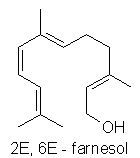
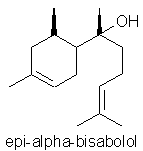
It was already
established by Piggot et al. (1997) that different sections of the WA Sandalwood
tree produce different compositions of oil, the epi-a-bisabolol
content increasing as one goes higher up the tree, whereas the desirable
santalols are highest in the buttwood. Cropwatch
has obtained documents, pertaining to nearly 400 separate analyses, which show
variations in the a-santalol
content alone from 6.0 - 24.5% according to the exact geographic locality from
which the wood of S. spicatum was taken within an area of S.W. Australia.
The search is on for compositionally higher santalol producing areas of S.
spicatum trees.
Finally, Piggott suggests
that S. spicatum and S.
album may be distinguished by the chiral ratios of b-bisabolol
to epi-b-bisabolol
(the (6R, 7S)-epi-b-bisabolol
isomer being favoured in S. spicatum
and (6R, 7R)-b-bisabolol
form being favoured in S. album.
Unscrupulous producers and traders may blend in W Australian sandalwood oil with
the scarcer and more costly EI oil, so the aforementioned may be a useful way of
helping to detect adulteration.
It might be instructive to look at some of the
published analytical data for some of the components of the oil of S.
spicatum.
| Constituent |
Fergeus
|
Brophy |
Brophy
2 |
Piggott |
[S.
album] |
| b-santalene |
2.2% |
|
|
|
2.03% |
| a-santalol |
25% |
9.1%
(Z) -a-
isomer |
|
10.0% |
44.23%
(+)-(Z)- a
isomer |
| b-santalol |
14% |
5.4% (Z)-b-
isomer |
8.1% |
3.8% |
23.51%
(-)-(Z)-b-
isomer |
| a-bergamotol |
5% |
|
|
|
4.12%
(E)-isomer |
| Nuciferols |
S:
16% |
6.5%
(Z)- (isomer |
6.9%
(Z)-isomer) |
2.2% |
2.37%
(Z)-isomer) |
| (Z)-lanceol |
2% |
|
|
|
1.52% |
| epi-a-
& b-bisabolol |
S:
7% |
10.7%
(epi-a-
isomer) |
6.6% (epi-a-isomer) |
3.1% |
|
| 2E,6E-farnesol |
5% |
31.6% |
11.0% |
5.3% |
|
Sources Fergeus J (undated pamphlet) =
“Australian Sandalwood Aromatic
Review” Australian Botanical Products Pty
Ltd.
Brophy= JJ Brophy et al. (1991) analysing
trunkwood oil
Brophy 2= JJ Brophy et al. (1991) analysing
buttwood oil
Piggott et al. = Piggott et al. (1997)
analysing buttwood oil
S. album
= T. Burfield (2004) unpublished data, commercial oil
However this appears to be quite different
information on Santalum spicatum
composition from that supplied on Lebermuth’s website (which can be seen in
full on http://www.lebermuth.com/oilmonth.html)
courtesy of John Fergeus, illustrating Kerr’s point that ”…this has lead
to several (aromatically) different essential oils being produced for different
markets or purposes” (Kerr 2000).
| Compound |
S.
spicatum % |
S.
album % |
| -bisabolol |
3% |
|
| cis
–santalol |
25% |
50% |
| epi
–bisabolol |
4% |
|
| cis
tr –bergamotol |
5% |
3% |
| cis
-santalol |
11% |
20% |
| E,E,
farnesol |
5% |
|
| cis
nuciferol |
11% |
1% |
| trans
nuciferol |
5% |
1%
* |
* cis-nuciferol,
surely?
(NB As you can see, the Greek lettering
denoting the correct isomers appears not to have survived the transfer, on my
browser anyway! For example cis-santalol should be cis-alpha-santalol).
Pigott, looking at the Brophy et al.’s
results and considering Penfold’s earlier work (Penfold 1928 & 1932),
speculates that 3 chemotypes of S. spicatum might exist, where epi-a-bisabolol,
farnesol or a-
& b-santalols
predominate in the oil from the mid-trunk sections upwards.


It is generally acknowledged that the
santalols add to the fine woody notes of EI sandalwood odour, the term santalols
first being coined by Parry (1895). (+)-Z-alpha-santalol
is however somewhat weak & cedarwoody – the distinguished perfumer Arcadi
Boix Camps (2000) notes that the material has a weaker, less floral and more
resinous odour (in comparison with a synthetic Sandalwood reference compound:
Sandela) and the author goes on to say he considers it’s value more fixative
than olfactory. (-)-Z-beta-santalol is
considered the finer sandalwood odoured material, which Arcadi Boix Camps (2000)
considers is floral-radiant. Other
commentators describe (-)-Z-beta-santalol as the santalol isomer having greater
olfactory significance (Brunke E-J 1983), or describe superior fine woody notes,
especially adding to the animalic urinous character of the oil (Ohloff G 1994) .
It should be noted that 40% of subjects are anosmic to this aspect of the oil.
Other sandalwood constituents have also been examined for their odour
contributions, such as
(-)-alpha-santalene (weak, woody) and
(-)-beta-santalene (cedarwood like) .
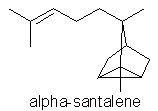
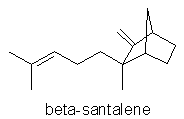
These sesquiterpene hydrocarbons may
well be removed in the first fractions of redistillation or rectification
together with the unpleasant degradation product 1-furfuryl pyrrole (which has a
coffee or popcorn-like odour nuance at extreme dilution). This procedure
improves the overall odour profile of the product.

However Brunke & Hammerschmidt
(1980) referring to the work of Demole (1976) who analysed the first runnings of
EI sandalwood redistillation, identifying 46 compounds, maintain that these
minor components round off the olfactory image and say that “the true value of
sandalwood to the perfumer lies in the smell & fixative properties of its
sesquiterpene alcohol fraction and is fully realised only in composite
fragrances”.
One of the more interesting components,
probably corresponding to Arcadi Boix Camps term bergamottol (possessing a
strong milky oriental aroma), is the investigation and characterisation of nor-a-trans-bergamotenone (Brunke & Schmaus 19995).
Although only present at 0.01%, its high aroma adds
fatty-nutty and milky odour aspects to the top-note of the EI oil (as
proven by aroma extract dilution techniques). This is mentioned because it may
be another factor in the differing odour profiles of WA as opposed to the EI
oil.
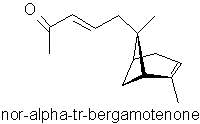
However it was found by Brunke & Schmaus (1995) that concentration of
fractions containing (-)-Z-alpha-tr-bergamotol
(which is present in WA sandalwood oil) and (+)-Z-alpha-santalol resulted
in mixtures with the strong fatty-nutty and milky odours.
Other components of West Australian sandalwood oil include (Z)-nuciferol
& (Z)-lanceol, which by themselves have both, possess weak woody
odours (Sideheswaran & Ganguli
1997).
Marketing confusion.
Cropwatch has an undated copy of a
15-page media release (plus many ancillary pages of promotional material)
apparently authored by Mount Romance,entitled “Sandalwood
Aroma-chology”.
This commercial promotional
material by a private company features, on page 9, the biography of Professor
Buchbauer, principle researcher of the Institute of Pharmaceutical Chemistry,
Vienna, since (page 2:) “In 2002/3 further research will elucidate the
pharmaceutical effects of inhalation of the fragrance and quantification of the
increased efficacy of the oil after inducing a psychosomatic connection with
deep relaxation”. The text seems to be in the future tense, whereas on page 7
we learn that Mount Romance Australia and the Institute of Pharmaceutical
Chemistry Vienna “have conducted a human clinical trial in order to confirm
the historical & anecdotal physiological effects of Australian sandalwood
oil”. There does not seem to be a reference to any publication of this work in
the document.
The appendices also feature biographies of Michael Roudnitska, perfumer-son
of the famous fragranceur Edmond Roudnitska, and Dr. Stephen Myers of the
University of Queensland, who (page 12:) is “Director of the Centre” –
perhaps meaning the School of Complementary Medicine, University of Australia.
On page 7 we learn that a human trial at the Australian Centre for Complementary
Medicine (2002) established that Australian sandalwood applied to human skin
induces relaxation. Again I am unable to follow the document sufficiently to
understand if a clearly inadequate reference on page 12 refers to this, or to
other work.
The layout of this document appears to be somewhat confusing to the author
(TB), since esoteric, spiritual and investigative work on Santalum
spicatum “oils” almost seamlessly combine with the traditional
properties and known benefits of Santalum
album, as if the two materials were exactly the same. Subject to
confirmation, in the references to the article, three out of five references
cited appear to refer to previous published work
on Santalum album. In one further
reference, again subject to confirmation, an article is cited which refers to
the properties of a (synthetic?) version of one particular aroma compound found
in the oil of Santalum spicatum. In
the fullness of time, many of the demonstrable therapeutic effects of Santalum
album may (or may not) be scientifically proven to be similar in Santalum
spicatum oils. Meanwhile, presentations such as this seem to trade on “the
good name of E.I. Sandalwood.” Cropwatch
is trying to track down many of the specific studies mentioned to critically
evaluate them, although they are often referred to as “unpublished” in much
of the promotional material released at the time.
Dubious
claims.
On page 31 (the page is
in fact unnumbered, but is the 31st page in sequence) of Aromatherapy
Today Vol 20 December 2001, in what appears to be an advertisement,
in amongst a total of eight claims, we read that:
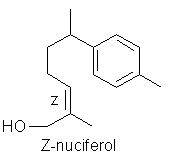
Comment:
in fact we have known for a considerable time that Santalum
album does contain (+)-cis-nuciferol
(see for example Brunke & Hammerschmidt 1980).
Comment:
As Santalum spicatum has not been
notified in the Annexes of the EU Biocides legislation at the moment of writing,
the future for biocidal use for this material in retailed products does not look
possible as matters currently stand. Since Australian and US legislation often
follows the European model the same situation may well eventually apply outside
the EU.
Comment:
This is a curious statement. East Indian sandalwood oil is typically steam
distilled, re-distilled and then rectified. Whilst solvent extraction of the
waste wood residues from the distillation is not absolutely unknown in India, it
is not common; it is true that oil produced in this way might on the odd
occasion be blended in with the steam-distilled bulk. On the other hand,
petrochemical solvents are used in the Mount Romance extraction process,
presumably for economic reasons, since McKinnell (1990) notes: “Significant
variations exist in the heartwood oil content between the commercially utilised
species: S. album & S. yasi average 5-7 percent, S.
austrocaledonicum 3-6 percent, depending on source, whilst S.
spicatum averages 2%. This last is
considered too low for distillation under present economic circumstances, and
(the wood) is only used for the incense trade.”
Comment.
Some facts about the four isomers of alpha-bisabolol:
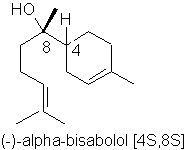
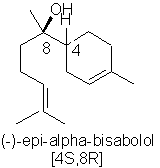
Kerr (2000) maintains
that solvent extraction is (only) utilised to increase the santalols content of
the S. spicatum extracted product
(“oil”). Gearon as project leader for Mount Romance had previously been
funded for 3 years by the Rural Industries Research & Development, the aims
of the project being described at http://www.rirdc.gov.au/comp02/eoi2.html#MRA-1A
. This source tends to support Kerr’s statement about intentions of producing
enriched fractional extracts of sesquiterpene alcohols at the expense of the
non-volatile components. However,
it also reveals the intended market for the product: “The pure alcohols or
their enriched concentrates will be used in the formulation of value added
products such as pharmaceuticals (anti-inflammatory and bacterial agents),
cosmetics/toiletries and fine perfumes.” Not “complete” oils for
aromatherapy you will notice, just specific enriched fractions for industries
that use such isolates. However practical the aim of yield optimisation, as we
noted above, is also described as, “A
secondary, but nonetheless indispensable, objective for the ultimate commercial
success of this project is the identification of all parameters influencing the
wood oil composition and oil yield.”
The Animal
Testing Saga.
Scantox (a “pre-clinical safety testing
laboratory” near Copenhagen, Denmark) carried out animal testing on the Mount
Romance WA Sandalwood “oil” at the behest of the WA government; the results
were widely referred to by Mount Romance, and apparently written up (Kauber K.
2000) but never released into the public domain. Requests by the author (TB) to
Scantox to have sight of this information have been declined in the past.
Gearon (2002), billed as Scientific Officer
for Mount Romance, appears not to acknowledge
this testing episode, saying in a critique
of Chrissie Wildwood’s article, Spotlight on the Trade in Wild Plants, “I would like to sight
(sic) the reference Ms. Wildwood refers to regarding the painful experiments on
laboratory rodents which demonstrate the anti-microbial, fungicidal and
anti-inflammatory properties of S.
spicatum. With respect, this is not correct. The above information is
ascertained using internationally standardised in-vitro assays utilising
micro-organisms and enzyme systems. There is no animal (well, not macroscopic,
anyway) experimentation involved at all.”
Before going any further, it is important to
mention that, for reasons unknown to CW, the
editor of Aromatherapy Today failed to
print the slightly revised version of her article,
wherein the association between animal testing and anti-inflammatory
properties had been cut. At no time
had CW intended to associate the anti-microbial tests with in-vivo assays, which
was a misunderstanding by Gearon. Before
publication of the article in Aromatherapy Today, CW realised that the
animal testing related to the acute oral and dermal toxicity tests, which were
referenced in the Mount Romance literature on Santalum
spicatum. The same reference
appeared in publicity material included on the Mount Romance website.
So, having deduced the exact nature of the
trials, CW wrote to Gearon requesting confirmation that these particular
toxicity tests had indeed been carried out on animals. Unfortunately, there was
no reply. As the magazine editorial
deadline was imminent, CW persuaded John Kerr, editor of Aromatherapy
Today, to contact Gearon himself. It
was essential for him to know the exact nature of the experiments since he was
selling Mount Romance sandalwood “oil” through his vegan essential oil
company, Springfields. Indeed, his
company was (and still is) listed as such by a number of animal welfare and
animal rights organisations in Australia. For
example, http://www.choosecrueltyfree.org.au/list.html
Finally, Mt. Romance obliged by revealing to
Kerr the exact nature of the toxicity tests.
In the editorial comment of the same issue of the magazine, Kerr makes no
reference to CW’s role in having revealed the truth about the Scantox tests,
but confirms:
“The oil was used in animal tests for oral and dermal toxicity in 2000. The tests were commissioned by the WA government to comply with both Australian and international regulations regarding the use of the oil in therapeutic and cosmetic products”. He also remarks, “While I am totally opposed to any form of animal testing, my real anger is towards governments who have such laws and place primary producers in commercially impossible situations.” We suggest that Kerr’s distress was partially misplaced and should also have been directed at Mount Romance for omitting to mention the animal testing prior to selling the aromatic to companies marketing health and beauty products under the ‘cruelty free’ banner.
Yet even before becoming aware of the animal
testing, as a vegan company trading in “cruelty free” products, Kerr could
see nothing incongruous about doing business with a company that also openly
marketed emu oil products! (Incidentally, Kerr no longer promotes the Mount Romance
sandalwood extract, but sells the steam distilled WA sandalwood oil obtained
from a different producer [Kerr 2003]).
The real fact of the matter, of course, is
that the EU Cosmetics Regulations reflect an ethical objection to animal testing
of which the WA government must have been unaware when they sanctioned the
tests. It is interesting to note that all references to the acute dermal and
oral toxicity undertaken as described are now removed from Mount Romance’s
website. However, the reference still remains elsewhere on the Internet; for
example, on page 2 of the following online brochure: http://www.bnaturals.com.au/Pdfs/Medicated_Honey_Brochure.pdf).
Ecological considerations.
Santalum lanceolatum
S. lanceolatum has been pronounced as endangered in Victoria and
has been listed as a threatened taxon under Schedule 2 of the Flora
and Fauna Guarantee Act 1988 (Flora & Fauna Guarantee Action Statement
No. 75 1996) – see the reference for Department of Natural Resources and
Environment (1996).
Santalum spicatum
We already know from the
experience with Santalum album that the heartwood only commences to form at 20
years, and is optimal at 30-50 years when the diameter is 10-20cm; incipient
heartwood formation occurring at 10 years when the diameter is 0.5 to 2 cm
(Mayar 1988). Since oil content is related to heartwood content, long
maturity times have to elapse before any species of Sandalwood trees are
worth uprooting for oil; however as indicated elsewhere, maturity time is
largely related to rainfall and many other factors. It is not accurately known
how long the WA sandalwood trees grown under plantation conditions will take to
reach maturity in specific locations. Estimates from producers in Australia have
been in the range of 12-15 years upwards, in contrast to Weiss’s comment
(Weiss 1997) with reference to the Australian situation that in the Kalgoorie
district of Western Australia at least, the estimated time to reach legal
felling size is 50-100 years. A fuller examination of the rate of growth of
heartwood and the changes in oil content over time is required in order to
determine the optimum time to harvest the crop.
The Sandalwood Amendment Act passed in 1996 exempted plantations from
government regulation. CALM subsequently promotes a share-farming scheme where
financial assistance and technical support is given to farmers.
An introduction to Santalum spicatum growing for farmers is available
(Denham 1998), which also states that the current export quantity of Sandalwood
from W. Australia in 1998 was 2200 tons per year (in apparent contrast to the
widely quoted 2000 tons CALM imposed limit). Perhaps
as a result of this deregulation, Mount Romance is also an agent who will assist
the Tropical Forestry Services Ltd (now CALM) in the selling of “Indian
Sandalwood” (Santalum album) in
plantations on behalf of investors in the Orid River Irrigation Area of Northern
Australia.
The financial reports of
the Orid River sandalwood project for 1993 end, drawn up by ITC Ltd, show 74 x 1
hectare plots associated with 71 investors, and 162 plots x 0.5 acres assigned
to 96 growers. Really then, this is a relatively tiny agro-forestry scheme. The
information on the investment pack states that “Tests
have shown that Indian Sandalwood trees grown in these circumstances are
producing heartwood at 5 years of age, and so long as current growth rates are
sustained, trees could be harvestable 12 years after planting.”
However, the authors are unable to find research material to justify such
optimistic predictions, for Santalum album cultivation is notoriously
difficult and remains in the experimental phase.
Radomiljac (2000) describes Santalum album plantations in
Kimberley growing on Sesbania formosa host trees, and Alternanthera nana as
pot host. Radomilijac describes trials with other host trees that were not
successful.
Even if it turns out to
be possible to harvest Santalum album within 12 years of planting, the
quality of oil produced is unpredictable at this stage of growth.
It’s also timely to remind ourselves that, according to Bolt (2001), at
least one high profile plantation investment company is in receivership as tax
deductions made by the company were deemed illegal by Australian tax collecting
bodies. In a further article, Tonts (2001) expresses skepticism about plantation
schemes in general, the associated monoculture, the excessive use of chemicals,
and the turning of large areas of farmland into forest. At first this seems to
be in conflict with Pakenham’s criticism of loggers and “all the other
energetic white Australians” who have reduced the area of virgin forest and
increased the fire hazard (Pakenham 2002). What we believe
Pakenham is saying is that mature green forests full of large majestic trees are
more likely to survive the ravages of fire than immature plantations, which will
be destroyed at a sweep.
As mentioned earlier, Santalum spicatum
is already much less common in the wild as the result of excessive harvesting
(Elliot 2002). Additionally, manual
seed dispersal systems for Santalum spicatum have had to be devised in
some areas, since the near extinction of the small marsupial known as the woylie
(by foxes and feral cats) has caused severe reduction in numbers of the trees.
The recommendation of reliance on seeding systems for Santalum spicatum
propagation (Lonergan 1990) seem at odds with the Timorese experience of failure
rates with this technique, the farmers relying on the equally important
vegetative regeneration (McWilliam 2001). Barret (1989) commenting about
relationships with suitable host species, remarks “The ecology of natural
sandalwood production in Timor (and elsewhere) is therefore complex and is
translated into significant variation of growth characteristics and heartwood development across the species.
Although there has been significant research on the ecology and silvicultural
aspects of the tree, a full understanding of ecological dynamics of sandalwood
is some way off” (Barret, 1989). Finally Dey (2002) remarks generally on
unsatisfactory aspects of silvicultural seed and vegetative propagation of
Sandalwood, noting problems with slowness and heterozygosity in population. This
has lead to the development of biotechnological cloning in bioreactors;
Dey, working in Karagpur, India, reporting on the partial successes using the
somatic embryongenisis technique, which still suffers drawbacks of producing a
proportion of imperfect plants.
Although CALM has allowed 2,000 tons of W Australian Sandalwood to be
harvested out of a total estimated national resource of 200,000 tons (CALM
2001), not all voices within the organisation are of one accord. Some producers
are claiming that even without a replanting scheme, there is enough sandalwood
in the arid regions to carry on exploiting for another 100 years. As Ian Kealley
of CALM points out (Kealley 2002), “What is forgotten is that the demand for
Sandalwood is likely to escalate as Asian sources continue to diminish and
pressure mounts to expand or maintain the harvest, even if it’s not
sustainable. Therefore such estimates amount to little in a continually
expanding market. It will take a strong government to resist the financial
incentives. Also, we can’t be certain that the new plantations will flourish
or expand sufficiently to replace the harvest from the natural stands.”
Kealley’s views have been dismissed by Aromatherapy trade oil sellers –
Kerr (2002) for example saying the remarks are “his personal opinion”. This
is true – and Kealley is one of the world’s leading authorities on Santalum
spicatum cultivation!
Further, Mulholland (1994) constructed an economic model of the W. Australian
sandalwood industry concluding that profit maximisation in an inelastic demand
scenario would require the felling of 7340 tons of wood per year. Mulholland
further argues the case that in 40 years time sandalwood availability will limit
the price to the extent that profitability will cease.
The most important point to remember is that the new plantations of Santalum
spicatum are sited in the wetter Wheatbelt region, which is at least 1,000
km (620 miles) from where the majority of trees are being uprooted in the
parched interior of Western Australia. According
to Kealley (2002), sandalwood trees in the arid regions grow extremely slowly.
So, for straightforward reasons of economics, they are not being replanted in the
arid regions. Indeed, the state subsidised Australian sandalwood industry is not
prepared to wait upwards of 100 years for a return on its considerable
investment (see http://agspsrv34.agric.wa.gov.au/progserv/natural/trees/treecrop/SANDALW2.HTM
to confirm 100 year maturity information.
Therefore, until the Wheatbelt plantations 'come of age'
in about 50 years time, ancient slow-growing trees will continue to be uprooted
with absolutely no attempt to replant in the same place. Moreover, no one
to our knowledge has even considered the long-term consequences of tampering
with this unique and fragile semi-desert ecosystem – all for the frivolous
purposes of scent, cosmetics and opportunistic exploitation of the aromatherapy
market.
The information supplied above is
believed to be accurate, but views, comments, criticisms, corrections or
additional material can be forwarded to nodice@globalnet.co.uk
for consideration in future communiqués in the Cropwatch series.
BPC: British Phamaceutical Codex
CALM: Dept of Conservation & Land Management
d.b.h. : diameter at breast height.
ISO: International Standards Organisation
References:
Anon (2002) “A Crop in Crisis” – a section of “A Calming Influence”
Soap, Perfumery & Cosmetics
(Oct 2002) p42-3
Anonois D.P. (1998) Perfumer & Flavorist 23, 5(Sept/Oct 1998) p22.
Applegate Graham B, Davis Allan GW &
Annable Peter A (1990) “Managing Sandalwood for Conservation in N. Queensland,
Australia” in Proc of the symposium on
sandalwood in the Pacific : April 9-11, 1990, Honolulu, Hawai/technical
co-ordinators: Lawrence Hamilton, C. Eugene Conrad. Pub: Symposium on Sandalwood
Conservation (1st: 1991: Honolulu, Hawaii).
Arcadi Boix Camps (2000) Perfumery:
Techniques in Evolution Allured Publishing Corp, Carol Stream USA p7.
Barret D.R. (1989) “Santalum Album (Indian Sandalwood) Literature
Review” Mulga Research Centre Report No 3. Perth. Curtin University of
Technology.
Blacklow W.M. (2003) “Preface to Prospects for Biodiversity in Salinising
Landscapes” Australian Journal of
Botany, 51 Special Issue (6)
pp i - iv, December 2003.
Blacklow WM, Farrer SL & Launonoen TM (2003) “Prospects for Biodiversity in Salinising Landscapes” Australian Journal of Botany, 51Special Issue (6),
Bolt C. (2001) “Tax scheme controversy fells plantation timber company” The Financial Review 31 July 2001 p12.
Brophy J.J., Fookes C.J.R. & Lassak E.V. (1991) J.
Essen. Record Re.s 3, 381.
Brunke E-J. & Hammerschmidt F-J. (1980) “New constituents of East
Indian Sandalwood oil” 8th International Congress on Essential oils
Oct 1980 pub Fedarom 1982.
Brunke E-J. & Hammerschmidt F-J. (1988) “Constituents of East Indian
Sandalwood Oil – an eighty year old stabilty test” Dragoco Report
4/1988 pp107-113.
Brunke E-J, Fahlbusch K-G, Schmaus G & Volhart (1997) “The chemistry of
sandalwood odour – a review of the last 10 years”. In Rivista Ital. EPOS (Actes
des 15emes Journeés Internationales Huilles Essentielles; Digne-les-Baines,
France 5-7th Sept 1996 special issue 01/97) pp49-83.
Brunke E-J (1983) “Woody Aroma Chemicals” Dragoco
Report 6/1983 p146
Brunke & Schmaus (1995) “New active odour constituents in Sandalwood
Oil: part 2: Isolation, structural elucidation and synthesis of nor-a-trans-bergamotenone”
Dragoco Report 6/1995 p245-257.
Butaud J-F, Raharivelomanana P, Bianchini J-P & Baron V. “A new
chemotype of Sandalwood (Santalum insulare Bertero ex A DC.) from Marquesas
Islands” J. Essen. Oil Res. 15, 323-6.
CALM (2001) (Dept of Conservation & Land Management 2001) “New
Sandalwood Contracts for Station Owners” Media Release 17th July
Perth: Dept of Conservation & Land Management.
Carle R., Fleischhauer I., Beyer J & Reinhard E. (1990) “Studies on the
origin of (-)-alpha bisabolol and chamazulene in chamomile preparations. Part 1.
Investigations by isotope ratio mass spectrometry (IRMS). Planta Med. 56,
456-460.
Demole E, Demole C & Enggist (1976) Helv. Chim. Acta 58,
737.
Denham R (1998) “Southern Sandalwood: an introduction” http://agspsrv38.agric.wa.gov.au/pls/portal30/docs/folder/ikmp/lwe/vegt/trees/f02798.pdf.
Department of Natural Resources and Environment Sept (1996): Action Statement
under section 19 of the Flora and Fauna Guarantee Act 1988 which can be viewed
at: http://www.nre.vic.gov.au/web/root/domino/cm_da/NRECPA.nsf/3d08e37a810f38b94a256789000ee6bb/971f2f3ff3f57cbb4a2567c8000a4b3c?OpenDocument#Conservation+S
Dey S. (2002)“Mass
cloning of Santalum album L. through somatic embryogenesis: scale up in
bioreactor.”
Sandalwood
Research News letter (Australia),
13, 1-3.
Elliot RW & Jones DR (2002) Encyclopaedia
of Australian Plants Vol 8 Lothian Books Melborn 2002.
Fergeus J. (2000) “What will be the next big oil from Australia” Perf.
& Flav. 25(6), 8-19.
Fergeus J. (undated pamphlet) “Australian Sandalwood Aromatic Review”
Australian Botanical Products Pty Ltd.
Gearon V. (2000) at http://www.essentiallyoils.com/Newsletters/October_2000_Newsletter/october_2000_newsletter.html
Gearon V. (2002) Aromatherapy Today 24, Dec 2002 p21
Henschke I. (2000) Sandalwood brings sweet smell of success. Landline. Australian /Broadcasting Corp http://www.abc.net.au/landline/stories/s206172.html
Isaac O. (1979) “Pharmacological Investigations with compounds of Chamomile” 1. On the pharmacology of (-)-alpha-bisabolol and bisabolol oxides (review).” Planta Med 35, 118-124.
Kauber K. “Australian Sandalwood oil – Acute Oral Toxicity and Acute
Dermal Toxicity”, Scantox, Denmark 2000 (unpublished).
Kealley I. (1987) “Management of Inland Arid and Semi-arid woodland forest
of W Australia” Proc Confer of Inst of
Foresters of Australia Sept 28-Oct 2 1987.
Kealley I. (2002)
Personal communication with author (CW).
Kerr J. (2000)
“Essential Oil Profile – Australian Sandalwood Oil” Aromatherapy
Today 15, 8-12.
Kerr J. (2002) “Editorial Comment” Aromatherapy
Today 24 Dec 2002 p32-33.
Kerr (2003) personal communication with John
Kerr to the authors
Kobashi (2003) personal communication with author (TB).
Lonergan O.W. (1990) Historical Review of Sandalwood (Santalum spicatum)
Research in Australia. Perth: Research Bulletin No 4 Dept of
Conservation & Land Management Dec 1990 p28.
Mayar R. (1988) “Cultivation Information, Exploitation & Protection of Santalum album” Advances in
Forestry research in India Vol II
p117-152.
McKinnell F.H. (1990) “Status of Management & Silviculture research on
Sandalwood in W Australia and Indonesia” in Proc
of the symposium on sandalwood in the Pacific : April 9-11, 1990, Honolulu,
Hawai/technical co-ordinators: Lawrence Hamilton, C. Eugene Conrad. Pub:
Symposium on Sandalwood Conservation (1st: 1991: Honolulu, Hawaii).
McWilliam A (2001) “Haumeni, not many: renewed plunder and mismanagement in
the Timorese Sandalwood Industry” Resource Management in Asia Pacific
Working Paper No 29 pub. Resource Management in Asia-Pacific Program,
Division of Pacific and Asian History, Research School for Pacific and Asian
Studies, The Australian National University, Canberra 2001.
Mullholland J. “An investigation of
the harvesting processing and export of Western Australia sandlewood (Santalum
spicatum).” -
abstract of Masters thesis Unversity of Australia; summary available at the
website of Institute of Foresters of Australia http://www.ifa.unimelb.edu.au/abstracts/master/1994/mulholland1994.htm
Nagaraja Rao (1939) J Ind Chem Soc Ind
Division 1939 2, 1.
Ohloff G (1994) Scent & Fragrances Springer-Verlag p175.
Pakenham T (2002) Remarkable
trees of the world Weidenfield & Nicolson UK.
Parry E.J. (1895) Pharm. Journ. Transact. 55, 118.
Piggot M.J., Ghisalberti E.L. & Trengove R.D. (1997) “West Australian
Sandalwood Oil: Extraction by Different Techniques and Variations of the Major
Components in Different Sections of the Same Tree” Fl.
& Frag. J. 12, 43-46.
Radomiljac A. (2000) see: http://users.bigpond.net.au/sellwood/kimsoc/pasttalk00.htm
RIRC (undated) see: http://www.rirdc.gov.au/champions/MtRomanceAustralia.html
Safstrom R (2002) Investigating Potential Bush Products in the Great South
Western Australia – Similar Projects, Key People and Organisations
Greenskills Inc.
Samson, Basil (1980): The camp at Wallaby Cross. Canberra: Australian
Institute of Aboriginal Studies; 199-202.
Sawyer (1892) through Applegate Graham B, Davis Allan GW
& Annable Peter A (1990) “Managing Sandalwood for Conservation in
N. Queensland, Australia” in Proc of the
symposium on sandalwood in the Pacific : April 9-11, 1990, Honolulu, Hawai/technical
co-ordinators: Lawrence Hamilton, C. Eugene Conrad. Pub: Symposium on Sandalwood
Conservation (1st: 1991: Honolulu, Hawaii).
Septimus G.W. Piesse (1855) The Art of
Perfumery pub. London: Longman, Brown, Green & Longmans p 73-4.
Shineberg D (They came for Sandalwood:
A study of Sandalwood Trade in The SW Pacific 1830-1865) Melborn University
Press 1967.
Sideheswaran P. & Ganguli S. (1997) “Sandalwood Substitutes – A
Review” in Supplement to the Cultivation & Utilisation of Aromatic
Plants pp123-130.
Statham P. (1990) “The sandalwood Industry in Australia: A history” in Proc of the symposium on sandalwood in the Pacific : April 9-11,
1990, Honolulu, Hawai/technical co-ordinators: Lawrence Hamilton, C. Eugene
Conrad. Pub: Symposium on Sandalwood Conservation (1st: 1991:
Honolulu, Hawaii). p26
Tonts M (2001) Sandalwood Market Study (Draft Report) Perth: Dept of
Agriculture.
Tonts M & Selwood J (2002) “Niche Markets, Regional Diversification and
the Reinvention of Western Australia’s Sandalwood Industry” Tijdschrift
voor Economische en Sociale Geografie 94(5),
564-575.
Tropical Forest Services Indian Sandalwood Investment Opportunity information
Memorandum (undated). Tropical Forest Services Ltd.
Walker G.T. (1968) “Sandalwood Oil, The Chemistry of oil of Sandalwood”, Perfum & Essent. Oil Rec. 59,
778-785 (1968)
Webb MA. (2000) Bush Sense National
Library of Australia.
Weiss EA (1997) Essential oil Crops
CAB International Oxford England p533.
Woodall GS & Robinson CJ (2003) “Natural diversity of Santalum
spicatum host species in south-coast river systems and their incorporation
into profitable and biodiverse revegetation” Australian Journal of Botany
51(6) 741 - 753
Valder C, Neugebauer M, Meier M, Kohlenberg B, Hammerschmidt F-J, Braun NA
(2003) “Western Australian Sandalwood oil – New Constituents of Santalum
spicatum (R.Br) A DC. (Santalaceae)” J.
Essent. Oil Res. 15, 178-186.
Valder C, Neugebauer M, Meier M, Kohlenberg B, Hammerschmidt F-J, Braun NA
(2003a) “Santalum spicatum (R.Br.) A
DC. (Santalaceae) – nor-Helifolenal and Acorenol Isomers: Isolation and
Biogenic Considerations” J. Essent.
Oil Res. 15, 381-386.